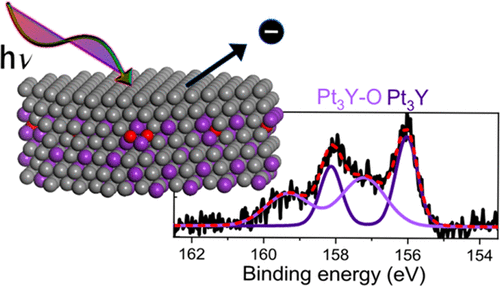当前位置:
X-MOL 学术
›
ACS Appl. Mater. Interfaces
›
论文详情
Our official English website, www.x-mol.net, welcomes your
feedback! (Note: you will need to create a separate account there.)
Unraveling the Surface Chemistry and Structure in Highly Active Sputtered Pt3Y Catalyst Films for the Oxygen Reduction Reaction.
ACS Applied Materials & Interfaces ( IF 8.3 ) Pub Date : 2019-12-23 , DOI: 10.1021/acsami.9b17817 Rosemary Brown 1 , Mykhailo Vorokhta 2 , Ivan Khalakhan 2 , Milan Dopita 3 , Thomas Vonderach 4 , Tomáš Skála 2 , Niklas Lindahl 1 , Iva Matolínová 2 , Henrik Grönbeck 1 , Konstantin M Neyman 5, 6 , Vladimír Matolín 2 , Björn Wickman 1
ACS Applied Materials & Interfaces ( IF 8.3 ) Pub Date : 2019-12-23 , DOI: 10.1021/acsami.9b17817 Rosemary Brown 1 , Mykhailo Vorokhta 2 , Ivan Khalakhan 2 , Milan Dopita 3 , Thomas Vonderach 4 , Tomáš Skála 2 , Niklas Lindahl 1 , Iva Matolínová 2 , Henrik Grönbeck 1 , Konstantin M Neyman 5, 6 , Vladimír Matolín 2 , Björn Wickman 1
Affiliation

|
Platinum is the most widely used and best performing sole element for catalyzing the oxygen reduction reaction (ORR) in low-temperature fuel cells. Although recyclable, there is a need to reduce the amount used in current fuel cells for their extensive uptake in society. Alloying platinum with rare-earth elements such as yttrium can provide an increase in activity of more than seven times, reducing the amount of platinum and the total amount of catalyst material required for the ORR. As yttrium is easily oxidized, exposure of the Pt-Y catalyst layer to air causes the formation of an oxide layer that can be removed during acid treatment, leaving behind a highly active pure platinum overlayer. This paper presents an investigation of the overlayer composition and quality of Pt3Y films sputtered from an alloy target. The Pt3Y catalyst surface is investigated using synchrotron radiation X-ray photoelectron spectroscopy before and after acid treatment. A new substoichiometric oxide component is identified. The oxide layer extends into the alloy surface, and although it is not completely removed with acid treatment, the catalyst still achieves the expected high ORR activity. Other surface-sensitive techniques show that the sputtered films are smooth and bulk X-ray diffraction reveals many defects and high microstrain. Nevertheless, sputtered Pt3Y exhibits a very high activity regardless of the film's oxide content and imperfections, highlighting Pt3Y as a promising catalyst. The obtained results will help to support its integration into fuel cell systems.
中文翻译:

揭示用于氧还原反应的高活性溅射Pt3Y催化剂膜的表面化学和结构。
铂是催化低温燃料电池中氧还原反应(ORR)的最广泛使用和性能最好的唯一元素。尽管是可回收的,但由于其在社会上的广泛使用,有必要减少当前燃料电池的使用量。将铂与稀土元素(例如钇)合金化可以使活性提高7倍以上,从而减少了ORR所需的铂量和催化剂材料的总量。由于钇易于氧化,因此Pt-Y催化剂层暴露于空气中会导致形成氧化层,该层可在酸处理过程中去除,从而留下了高活性的纯铂覆盖层。本文介绍了从合金靶溅射出的Pt3Y薄膜的覆盖层组成和质量的研究。在酸处理之前和之后,使用同步辐射X射线光电子能谱研究Pt3Y催化剂表面。鉴定了新的亚化学计量的氧化物组分。氧化物层延伸到合金表面,尽管用酸处理不能完全去除,但催化剂仍能达到预期的高ORR活性。其他表面敏感技术表明,溅射的薄膜是光滑的,块状X射线衍射显示出许多缺陷和较高的微应变。然而,无论薄膜的氧化物含量和缺陷如何,溅射的Pt3Y都具有很高的活性,这突出了Pt3Y是一种有前途的催化剂。获得的结果将有助于支持其集成到燃料电池系统中。鉴定了新的亚化学计量的氧化物组分。氧化物层延伸到合金表面,尽管用酸处理不能完全去除,但催化剂仍能达到预期的高ORR活性。其他表面敏感技术表明,溅射的薄膜是光滑的,块状X射线衍射显示出许多缺陷和较高的微应变。然而,无论薄膜的氧化物含量和缺陷如何,溅射的Pt3Y都具有很高的活性,这突出了Pt3Y是一种有前途的催化剂。获得的结果将有助于支持其集成到燃料电池系统中。鉴定了新的亚化学计量的氧化物组分。氧化物层延伸到合金表面,尽管用酸处理不能完全去除,但催化剂仍能达到预期的高ORR活性。其他表面敏感技术表明,溅射的薄膜是光滑的,块状X射线衍射显示出许多缺陷和较高的微应变。然而,无论薄膜的氧化物含量和缺陷如何,溅射的Pt3Y都具有很高的活性,这突出了Pt3Y是一种有前途的催化剂。获得的结果将有助于支持其集成到燃料电池系统中。其他表面敏感技术表明,溅射的薄膜是光滑的,块状X射线衍射显示出许多缺陷和较高的微应变。然而,无论薄膜的氧化物含量和缺陷如何,溅射的Pt3Y都具有很高的活性,这突出了Pt3Y是一种有前途的催化剂。获得的结果将有助于支持其集成到燃料电池系统中。其他表面敏感技术表明,溅射的薄膜是光滑的,块状X射线衍射显示出许多缺陷和较高的微应变。然而,无论薄膜的氧化物含量和缺陷如何,溅射的Pt3Y都具有很高的活性,这突出了Pt3Y是一种有前途的催化剂。获得的结果将有助于支持其集成到燃料电池系统中。
更新日期:2020-01-17
中文翻译:

揭示用于氧还原反应的高活性溅射Pt3Y催化剂膜的表面化学和结构。
铂是催化低温燃料电池中氧还原反应(ORR)的最广泛使用和性能最好的唯一元素。尽管是可回收的,但由于其在社会上的广泛使用,有必要减少当前燃料电池的使用量。将铂与稀土元素(例如钇)合金化可以使活性提高7倍以上,从而减少了ORR所需的铂量和催化剂材料的总量。由于钇易于氧化,因此Pt-Y催化剂层暴露于空气中会导致形成氧化层,该层可在酸处理过程中去除,从而留下了高活性的纯铂覆盖层。本文介绍了从合金靶溅射出的Pt3Y薄膜的覆盖层组成和质量的研究。在酸处理之前和之后,使用同步辐射X射线光电子能谱研究Pt3Y催化剂表面。鉴定了新的亚化学计量的氧化物组分。氧化物层延伸到合金表面,尽管用酸处理不能完全去除,但催化剂仍能达到预期的高ORR活性。其他表面敏感技术表明,溅射的薄膜是光滑的,块状X射线衍射显示出许多缺陷和较高的微应变。然而,无论薄膜的氧化物含量和缺陷如何,溅射的Pt3Y都具有很高的活性,这突出了Pt3Y是一种有前途的催化剂。获得的结果将有助于支持其集成到燃料电池系统中。鉴定了新的亚化学计量的氧化物组分。氧化物层延伸到合金表面,尽管用酸处理不能完全去除,但催化剂仍能达到预期的高ORR活性。其他表面敏感技术表明,溅射的薄膜是光滑的,块状X射线衍射显示出许多缺陷和较高的微应变。然而,无论薄膜的氧化物含量和缺陷如何,溅射的Pt3Y都具有很高的活性,这突出了Pt3Y是一种有前途的催化剂。获得的结果将有助于支持其集成到燃料电池系统中。鉴定了新的亚化学计量的氧化物组分。氧化物层延伸到合金表面,尽管用酸处理不能完全去除,但催化剂仍能达到预期的高ORR活性。其他表面敏感技术表明,溅射的薄膜是光滑的,块状X射线衍射显示出许多缺陷和较高的微应变。然而,无论薄膜的氧化物含量和缺陷如何,溅射的Pt3Y都具有很高的活性,这突出了Pt3Y是一种有前途的催化剂。获得的结果将有助于支持其集成到燃料电池系统中。其他表面敏感技术表明,溅射的薄膜是光滑的,块状X射线衍射显示出许多缺陷和较高的微应变。然而,无论薄膜的氧化物含量和缺陷如何,溅射的Pt3Y都具有很高的活性,这突出了Pt3Y是一种有前途的催化剂。获得的结果将有助于支持其集成到燃料电池系统中。其他表面敏感技术表明,溅射的薄膜是光滑的,块状X射线衍射显示出许多缺陷和较高的微应变。然而,无论薄膜的氧化物含量和缺陷如何,溅射的Pt3Y都具有很高的活性,这突出了Pt3Y是一种有前途的催化剂。获得的结果将有助于支持其集成到燃料电池系统中。









































 京公网安备 11010802027423号
京公网安备 11010802027423号